Are in-line filters necessary for amiodarone therapy?
In-line filters are not typically considered necessary for amiodarone therapy in all situations, but their use can provide several benefits and may be recommended in certain cases. Amiodarone is a medication used to treat irregular heart rhythms (arrhythmias), and it can be administered intravenously. Here are some considerations regarding in-line filters for amiodarone therapy:
Benefits of In-Line Filters:
Particulate Removal: In-line filters can help remove particulate matter or contaminants that might be present in the medication or the infusion system. This is important to prevent the introduction of particles into the patient's bloodstream, which could potentially lead to complications, including blood vessel occlusions or embolisms.
Improved Safety: The use of in-line filters can enhance the safety of intravenous drug administration by reducing the risk of particulate contamination, which can be particularly important when administering medications like amiodarone, which are delivered directly into the circulatory system.
When In-Line Filters Might Be Recommended:
Hospital Protocols: Some hospitals and healthcare facilities have protocols in place that require the use of in-line filters for certain intravenous medications, including amiodarone. This can be a matter of institutional policy or preference.
High-Risk Patients: In-line filters may be more strongly recommended for patients at a higher risk of complications from particulate contamination. This could include patients with compromised immune systems, a history of blood clots, or other factors that increase the risk of adverse events.
Long-Term Therapy: If a patient is receiving long-term amiodarone therapy, the use of in-line filters may be considered to reduce the cumulative risk of potential complications.
Pediatric Patients: In some cases, in-line filters may be recommended for pediatric patients to reduce the risk of adverse events associated with particulate contamination.
The decision to use in-line filters for amiodarone therapy is typically made by healthcare providers based on a risk-benefit assessment. It's important for healthcare professionals to consider the specific needs of each patient, the duration of therapy, and the overall safety profile of the medication. Patients and caregivers should discuss any concerns or questions about their treatment with their healthcare providers to ensure they are receiving the most appropriate care.
In-Line Filters for Amiodarone Therapy: Necessity and Benefits
Amiodarone is a powerful antiarrhythmic medication that is used to treat a variety of heart conditions. However, it is also known to cause a number of side effects, including phlebitis (inflammation of the vein). Phlebitis is a common complication of amiodarone therapy, and it can be severe in some cases.
In-line filters are devices that are inserted into the intravenous (IV) line during amiodarone administration. These filters trap particles in the amiodarone solution, including microcrystals and impurities. This can help to reduce the risk of phlebitis and other complications.
The use of in-line filters for amiodarone therapy is recommended by a number of professional organizations, including the American Heart Association and the American Society of Health-System Pharmacists. In-line filters are also required by some hospitals and healthcare organizations.
Amiodarone Infusion Safety: The Role of In-Line Filters
In-line filters play an important role in amiodarone infusion safety. By trapping particles in the amiodarone solution, in-line filters can help to reduce the risk of a number of complications, including:
- Phlebitis
- Thrombosis (blood clots)
- Emboli (blood clots that travel to other parts of the body)
- Air embolism
- Extravasation (leakage of the amiodarone solution into the surrounding tissues)
In addition, in-line filters can help to improve the quality of the amiodarone infusion. By removing particles from the solution, in-line filters can help to ensure that the amiodarone is being delivered to the patient in a safe and effective manner.
Filtering Amiodarone Infusions: Importance and Use
Filtering amiodarone infusions is an important step in reducing the risk of complications and improving the quality of the infusion. In-line filters are the most effective way to filter amiodarone infusions.
To use an in-line filter, simply insert it into the IV line between the IV bag and the patient's IV catheter. The filter should be placed as close to the patient as possible.
In-line filters should be changed every 24 hours, or more frequently if necessary. If the filter becomes clogged or damaged, it should be replaced immediately.
Healthcare professionals should be familiar with the use of in-line filters for amiodarone therapy. They should also be able to identify and manage any complications that may arise.













